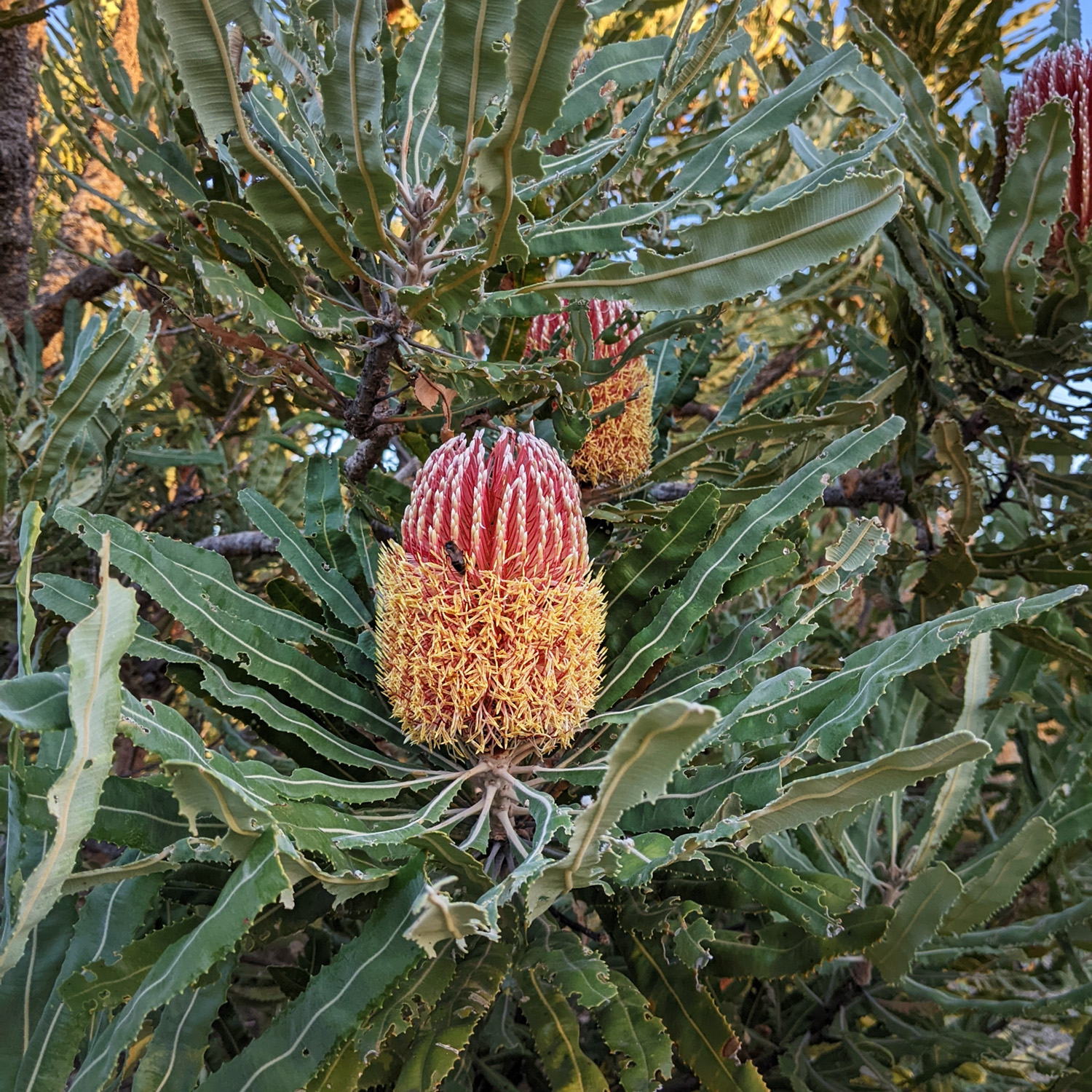Since 2018, Perth NRM has been delivering 'Living Landscapes: Improving the condition of Threatened Ecological Communities' in the Swan NRM region and working to improve the resilience of these important ecological areas.
These vulnerable and endangered areas are extremely important and valuable for retaining regional biodiversity and supporting the plethora of creatures who depend on them for food and habitat.
This project addressed six threatened ecological communities, identified as regional priorities, with funding received from the Australian Government’s National Landcare Program to care for:
- Clay Pans of the Swan Coastal Plain
- Banksia Woodlands of the Swan Coastal Plain
- Shrublands and Woodlands on Perth to Gingin Ironstone of the Swan Coastal Plain
- Shrublands and Woodlands on Muchea Limestone of the Swan Coastal Plain
- Shrublands and Woodlands of the Eastern Swan Coastal Plain (Swan Coastal Community 20c)
- Corymbia calophylla – Kingia australis Woodlands on Heavy Soil (Swan Coastal Plain Community Type 3a)
Working collaboratively with delivery partners – Department of Biodiversity, Conservation and Attractions (DBCA); Ellen Brook Integrated Catchment Group (EBICG); and South East Regional Centre for Urban Landcare (SERCUL) – across 15 sites implementing resilience-building measures across more than 2169.45 hectares.
Activities included:
- revegetating more than 16 hectares of habitat,
- the integrated management of priority and threatened weeds accumulating to 2990 hectares over the 5 years of control ,
- controlling pest animals such as foxes, cats, feral bees, deer, and pigs.
- 14 kms of fencing installed
- 113 community and stakeholder events
This not only helped to preserve these areas, but also helps us to better understand and manage these important ecological communities.
As the project is coming to its five-year completion date, let’s take a closer look at what has been accomplished in each community.
Clay Pans of the Swan Coastal Plain
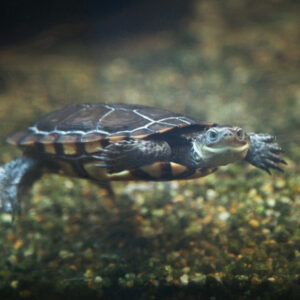
Unlike many seasonal wetlands that are connected to groundwater reservoirs, Clay Pans are a type of wetland that rely on rainfall. During summer the clay-based soil dries in the basin, almost impenetrable until the next rains.
Despite their barren appearance in summer, these wetlands support a diverse range of plant species that align their growth, flowering, and germination to the wetland’s lifecycle, with many species found only in the Swan Coastal Plain region. Many fauna species also rely solely on the claypans for food and habitat including four species of native bees, as well as Australia’s rarest reptile, the critically endangered Western Swamp Tortoise (Pseudemydura umbrina). Due to urban and agricultural development, and the invasion of pest weed plant species, the Clay Pans of the Swan Coastal Plain are now considered a critically endangered ecological community.
Work was done across four sites – totalling more than 740 hectares – including Brixton Street Wetlands, Ellenbrook Nature Reserve, Lake Wannamal, and Forrestdale Lake Nature Reserve. Thanks to project delivery partners – South East Regional Centre for Urban Landcare (SERCUL) and Ellen Brockman Integrated Catchment Group (EBICG) – 1322 ha of priority weed management activities were completed, along with over 1500 ha of managing pest animals, and the installation of nearly 11km of fencing to control access and increase the protection of the reserves.
Did you know that Greater Brixton Street Wetlands has over 650 different native plant species!
Want to do your bit? Join the Friends of Greater Brixton Street Wetlands in their planting events and regular busy bees!
Image: Western Swamp Tortoise at Perth Zoo, by Erinna Ford
Banksia Woodlands of the Swan Coastal Plain
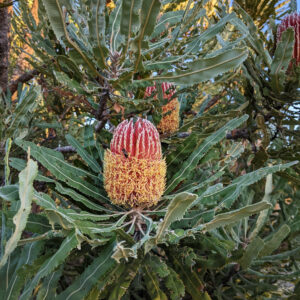
With some trees growing to a height of up to 10 to 12 metres, a Banksia Woodland is dominated by larger Banksia species including Candlestick Banksia (Banksia attenuate) and/or Firewood Banksia (B. menziesii). Other species might share the space, including eucalyptus, sheoak, cypress, and wattles, as well as a rich understorey of shrubs, climbers, sedges, perennials, and orchids, but banksias dominant the landscape.
This diversity might be surprising, given the low nutrient sandy soil, but it is an essential community that supports a broad range of fauna from birds, mammals, frogs and reptiles. The honey possum (Tarsipes rostratus) particularly relies solely on banksias for food, as well as all species of the critically endangered black cockatoo species – the Forest Red-Tailed Black Cockatoo (Calyptorhynchus banksii naso), Baudin’s Cockatoo (Calyptorhynchus baudinii), and the Carnaby’s Cockatoo (Calyptorhynchus latirostris).
Banksia woodlands have been reduced to just 40% of their original size and range, from a median size of 146 hectares to approximately 1.6 hectares per site, with large distances between each – one of the reasons for their status as an endangered ecological community.
Work within this threatened ecological community has been completed with delivery partners – South East Regional Centre for Urban Landcare (SERCUL) and Ellen Brook Integrated Catchment Group (EBICG) – across eight sites, including nature reserves in Chittering, Mindarra, Kenwick, Karnup, and Ellenbrook – totalling 1,500 hectares. Activities included flora surveys, dieback management, controlling priority weeds and pest animals, and planting seedlings to aid revegetation.
Want to get involved? Friends of Paganoni Swamp hold regular events and welcome new volunteers.
Image: Firewood Banksia (Banksia menziesii) by Miriam_98 / Atlas of Living Australia
Shrublands and Woodlands on Perth to Gingin Ironstone of the Swan Coastal Plain
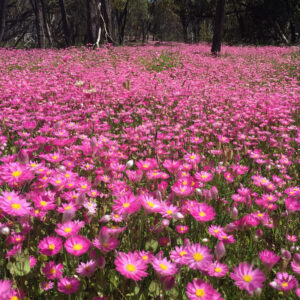
Typically found on the eastern side of the Swan Coastal Plain, in a small area south of Gingin, Ironstone ecological communities support a range of hardy shrubs including species of Kunzea, Grevillea (including the rare Grevillea curviloba subsp.Incurve), Melaleuca, and Acacia as well as popular annual mass display of Rhodanthe everlasting wildflowers. The ironstone sits beneath a layer of heavy iron-rich and clay soils – it does not provide access to underground aquifers, meaning wildflowers and other plants rely on the winter rains being trapped in this top layer of soil.
Perth NRM’s Threatened Ecological Communities Program has supported Ellen Brockman Integrated Catchment Group to deliver 159 ha of feral animal control and installing fencing to control and manage access.
Listed as a critically endangered ecological community, it is estimated that 97% of this soil type has been cleared for agricultural purposes. Its major threats include invasion by weeds, grazing by stock animals, and a drying climate. The largest remaining example of Gingin Ironstone is a 76-hectare site, containing 35ha of the community – nearly all of what is left of this ecological community.
Image: Rhodanthe manglesii by Pimelea / Atlas of Living Australia
Shrublands and Woodlands on Muchea Limestone of the Swan Coastal Plain
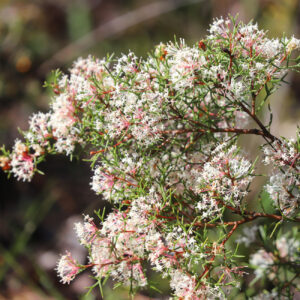 As the name suggests, the Muchea Limestone ecological communities exist in limestone soils – commonly found on the coast – but what makes this community unusual is that it is situated much further inland, around Muchea as well as north of Gingin. Appearing as both wetlands and well-drained landscapes, the flora commonly found include Sheoak trees, Mallees, Myrtles and Grevilleas including 11 threatened plant species and two endangered Grevillea species (Grevillea curviloba subsp.), along with a rich understorey of small annuals.
As the name suggests, the Muchea Limestone ecological communities exist in limestone soils – commonly found on the coast – but what makes this community unusual is that it is situated much further inland, around Muchea as well as north of Gingin. Appearing as both wetlands and well-drained landscapes, the flora commonly found include Sheoak trees, Mallees, Myrtles and Grevilleas including 11 threatened plant species and two endangered Grevillea species (Grevillea curviloba subsp.), along with a rich understorey of small annuals.
Being so different from the usual black soils of the Swan Coastal Plain, the limestone was historically quarried while also being cleared for agriculture. This has reduced the community to less than 10% of its original geographical distribution, with only 73 hectares of isolated remnants remaining. Other ongoing threats include damage done by grazing, weed evasion and inappropriate fire regimes.
Our delivery partner, Ellen Brockman Integrated Catchment Group, has been undertaking revegetation and other resilience-building activities to help the recovery of a small 0.6 hectare section of this rare community.
Image: Grevillea curviloba sp. by Arthur Chapman / iNaturalist
Shrublands and Woodlands of the eastern Swan Coastal Plain
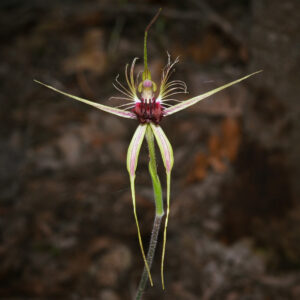
While there are numerous bushlands within Perth, there are only a few special locations that are classified as the endangered Shrublands and Woodlands of the Eastern Swan Coastal Plain. Located along the ridge that transitions the Swan Coastal Plain to the Darling Scarp, they feature plants that are found in both areas. This serves as an important corridor for plant biodiversity, as well as providing the food and habitat points for the fauna that rely on them.
Candlestick Banksias (Banksia attenuate) and Firewood Banksias (Banksia menziesii) are the dominant species, but the habitat is also home to Sheoaks, Woollybush, Pea species, Hakeas, and other annual and perennial species, including orchids such as the endangered King Spider-orchid (Caladenia huegelii). As with any amazing remnant bushland, these woodlands support a wide range of animals, including the critically endangered honey possum (Tarsipes rostratus).
Tragically, less than 1% of the original 14,414 hectares remains, cleared for urban development, agricultural and forestry purposes, with just 79 hectares of the community remaining. Perth NRM’s Threatened Ecological Communities Program has supported Ellen Brockman Integrated Catchment Group to deliver weed control, revegetation and disease management activities to improve one of the largest remaining reserves resilience..
Image: King Spider-Orchid (Caladenia huegelii) by Stephen Buckle / iNaturalist
Corymbia calophylla – Kingia australis Woodlands on Heavy Soil (Swan Coastal Plain Community Type 3a)
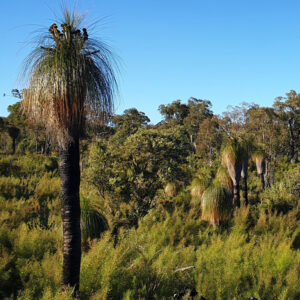
While these two plant species – Marri (Corymbia calophylla) and Kingia (Kingia australis) – are commonly found in a variety of locations and soil types, this specific ecological community is unique in that it grows in soil that contains an impervious clay layer. This traps water closer to the surface, and supports a range of plants that rely on this inundation during wetter months, including Xanthorreas, Hakeas, Banksias, Dampiera, as well as several species of declared threatened and priority flora species.
Occurring from Bullsbrook to Bunbury, this threatened ecological community has been reduced by 97% of its original distribution due to land clearing, weed invasion, the introduction of Dieback disease, and salination of groundwater. Now, only 83 hectares remain across ten different sites. Perth NRM’s delivery partner – Ellen Brockman Integrated Catchment Group – has been working on a 147 hectare reserve in Stratton containing 30 ha of the remaining threatened ecological community. Activities completed include weed mapping, removing weeds, and a flora survey.
Image: Kingia (Kingia australis) by Thys Meintjes / Atlas of Living Australia
Tuart (Eucalyptus gomphocephala) woodlands and forests of the Swan Coastal Plain
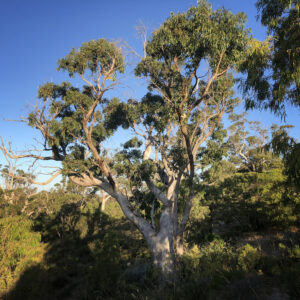
As the name suggests, Tuart woodlands predominately feature Tuart trees (Eucalyptus gomphocephala) as the canopy tree, growing to a height of 40 metres – the largest tree species in the region. Depending on their geographical location, the sites might also heavily feature Peppermint trees (Agonis flexuosa) to the south and Banksias species to the north, while the composition of the understorey may range from densely shrubby to being very open with only native daisies, sedges, and orchids growing beneath the trees.
The Tuart woodlands are a refuge within largely cleared landscapes and support a broad range of fauna, including at least 43 species of reptiles – more than half of the species found in the entire Swan Coastal Plain. Along with other hollow-dwelling mammals and birds including the black cockatoos species, the critically endangered Western Ringtail Possum (Pseudocheirus occidentalis) and Southern Brush-tailed Phascogale (Phascogale tapoatafa Wambenger) rely on the woodlands for their food and habitat. Only 20% of the original Tuart woodlands and forests remain with a reduced median patch size of 6.3 hectares putting a strain on the diverse animal and populations they support.
Listed as Critically Endangered by the EPBC act in July 2019 Perth NRM has nominated Tuart woodlands for future resilience building activities pending successful federal funding.
Image: Tuart (Eucalyptus gomphocephala) by Dean Beaver / iNaturalist
Conclusion
Plants might not spark the interest of the population as much as our adorable and unusual native animals. But these creatures rely on the biodiversity and interconnected relationships that are found in the ecological communities that are at threat.
It is only through collaboration and working closely with other organisations that these important and threatened ecological communities can be preserved and protected. Plans are underway to continue the work in these ecological communities, with our invaluable project partners, and doing our bit to ensure these essential biodiverse areas and species are supported for years to come.
For more information about our projects, please contact: [email protected]
Perth NRM’s Threatened Ecological Communities program is supported by funding from the Australian Government’s National Landcare Program.
Article sources
Partners
We acknowledge and appreciate the support of all our partners, supporters, funding bodies and sponsors.

